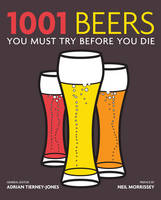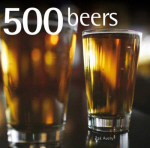
Adrian Tierney-Jones, ed, 1001 Beers You Must Try Before You Die
Discerning beer drinkers turning to the bookstore for advice on what to try next currently face an unprecedented choice, with beer writers and publishers queueing up to provide definitive lists of international beers. 3 May sees the British publication of doorstop-sized tome 1001 Beers You Must Try Before You Die, edited by Adrian Tierney-Jones, the latest in a wave of such exercises in zythological canon-forming. The handsome World’s Best Beers, mainly penned by dynamic drinks writer Ben McFarland, appeared last Autumn, while another award-winning writer, Zak Avery, revealed his 500 Beers in March. Meanwhile the pioneer example of the genre, 300 Beers to Try Before You Die! by veteran beer writer Roger Protz, was revised and updated in February.
This last comes from CAMRA Books, one of the leading specialists in the field, but the others are all from mainstream publishers. Ben’s and Zak’s books come from well-respected independent “lifestyle” publishers: Aurum and Apple respectively. I declare an interest in Adrian’s book as I’m one of the less prominent of a starry cast of contributors, but it’s arguably the most significant in publishing terms, standing alongside sister volumes on wines, books, films and places to visit in the popular 1001 Before You Die series from international group Quarto Publishing.
These books document a changing landscape. 15 years ago, nearly all the must-read volumes for British beer lovers came from CAMRA Books, which, despite their strengths, would always be perceived as for a specialist, and not particularly trend-setting, audience. The new books represent a far more general pitch from “lifestyle” publishers who clearly now believe there is an opportunity to position the appreciation of good beer alongside the enjoyment of all the other good things in life. They’re targeted squarely at the kind of educated, discerning and eclectic consumer beer writers have long dreamed of cultivating, with a generally broad and unprejudiced selection that even occasionally widens to post-modern irony to embrace iconic industrial beers — 1001 Beers, for example, includes Pabst Blue Ribbon. Whether or not such consumers yet exist in sustainable numbers remains to be seen, but publishers like these don’t invest in big and colourful books just for the love of it.
The chief exceptions to the CAMRA monopoly back in the day were the books of the great Michael Jackson, who took a genuinely international approach to beer appreciation, unhindered by ideological commitment to live yeast. When I first developed a serious interest in beer in the 1990s, Michael’s diminuitive Pocket Beer Book (last published in 2000 by Mitchell Beazley) was a key source that I combed for recommendations for my own wants list. The book was particularly strong on the traditional European brewing countries of the UK, Belgium and Germany, but among Michael’s many other achievements was raising awareness in Europe of the new and vibrant craft beer culture emerging on the other side of the Atlantic. Still, you get the impression that the US breweries he featured were based less on selecting the best of the whole country and more on the places he’d managed to visit — not surprisingly for one man confronted by such a vast territory.
This too has changed, with the development of a well-connected international community of beer critics, industry figures and superfans able to give a more comprehensive appreciation of the world’s brewing scene and to evolve at least some sort of consensus about its most outstanding and representative products. The vehicle for this has, of course, been the internet — tellingly, the list of 1001 Beers‘s 43 contributors includes many names familiar from blogs and other online beer sites. And given the wealth of content that all these people obligingly make available for free online, it’s reassuring that there still appears to be a demand for substantial and authoritative books of this kind.
This communication has also facilitated much international cross-fertilisation of both brewing practice and beer appreciation, and the books mark a clear shift in the dominant energy source from the Old World to the land of the free and the home of the brave. Though the books originate in Britain they are also being published in the US and the publishers will have one eye on flattering that market (for 1001 Beers I was briefed to use American terminology and spellings), but there’s no denying the innovation, imagination and quality of US craft brewers revealed in page after page devoted to fascinating American beers. Perhaps more significantly, it’s also clear that if you’re working to establish a new brewing scene in a country that either lacks a native tradition or has had that tradition obliterated, you’re no longer likely to look first to Britain, Belgium or Germany directly for inspiration, and if you appropriate their styles it’s in a form mutated by the energy and capacity for imaginative reinvention of US craft brewers.
An excellent example of this is Italy. For its 2000 edition, Michael Jackson expanded the country’s coverage in his Pocket Beer Book to four pages, noting besides old established industrial brewers based on Germanic models the emergence of a handful of intriguing and eccentric new micros such as Baladin and Birrificio Italiano. Today, Ben McFarland includes a substantial chapter on Italian brewing, stating that “of all the up-and-coming brewing nations, Italy is the one to watch,” while Adrian Tierney-Jones’ book references over 25 Italian brewers. Their shared ethos has much to do with specifically Italian factors such as the traditional indigineous appreciation of la dolce vita and recent trends such as Slow Food, but it’s difficult to imagine the hugely exciting range of beers they produce would have emerged in quite the same way without the American example of iconoclasm, experimentation and “extreme beer”.
So are the books themselves as essential as the beers they feature? The first edition of Roger Protz’s 300 Beers established a precedent for choosing from a diverse palette and was refreshingly free of CAMRA yeast purism (which, to be fair, rarely troubles CAMRA books other than the Good Beer Guide). Its new incarnation keeps the same design and much the same selection, which is now starting to look rather traditional. Ben McFarland’s is a beautifully designed and presented large format volume taking a country-by-country approach, and gifted with its author’s distinctive, perceptive, inventive and always entertaining if occasionally overwritten prose, which hits such an infectiously celebratory note I can forgive its occasional minor factual errors. Ben has wisely deferred to guest writers when covering particular areas or topics where his expertise would be stretched, so you can also enjoy informed comment from the likes of Canadian Stephen Beaumont and beer and seafood recipes from Rick Stein. Zak Avery’s guide is more modestly proportioned and neatly arranged by style with clever “at-a-glance” assessments of colour and body, though some beers have been forced rather uncomfortably in their categories for the sake of format. The book has a more personal feel, but as the manager of one of Britain’s leading specialist beer shops, Zak is well-placed to make an informed and comprehensive selection.
If you’re like me you’ll want all these books, but if I had to choose just one, I genuinely believe, setting my personal interest aside, that I’d pick 1001 Beers. As a collaborative work, it takes best advantage of that international consensus I referred to earlier, offering a variety of voices and even bringing in writers from non-Anglophone countries who write fluently in English, resulting in an authoritative survey of the current world beer scene. It offers a mouthwatering list which Adrian has chosen to order in a few very broad colour categories, and each beer is profiled by a writer specifically picked for his or her familiarity with it. And there’s something appealing about the 1001 Before You Die format which immediately tempts you to reach for the ticking pencil.
One flaw of all these books is their tacit collusion in the fallacy that canon forming with beers operates under the same conditions as canon forming with the products of the creative industries. Films, books, paintings and albums are relatively fixed entities and where there are variant texts of a work the differences are usually clear. Beer, on the other hand, is a perishable, living product, made using a complex process from a variety of ingredients. Even two casks or bottles from the same batch will change in flavour due to age or conditions of storage and dispense, and while brewers generally aim for as much consistency as possible within the limitations of the brewing process, there are good and not so good reasons for deliberately changing recipes, brewing kit and processes. So there’s no guarantee that the beer you try will taste exactly the same as the sample on which the writer based his or her writeup. This by no means invalidates the exercise — beer’s mutability is part of its charm — but it surely at least requires acknowledgement.
Finally, I’m glad to note that a good proportion of the beers listed in these books still haven’t been ticked off or in many cases yet added to my personal wants list. Another reason to keep living as long as possible!
Buy the books from amazon.com:
- Adrian Tierney-Jones (ed), 1001 Beers You Must Try Before You Die
- Ben McFarland, World’s Best Beers: 1000 Unmissable Brews from Portland to Prague
- Zak Avery, 500 Beers
- Roger Protz, 300 Beers to Try Before You Die!, Revised and updated
Selected reviews
Below are listed all the beers I’ve reviewed for 1000 Beers. Some of the reviews were cut for length in the book, so with the publishers’ permission I’ve included the full length versions here.
- Achel 8 Blond 8% Hamont-Achel, Limburg, Vlaanderen
- Achouffe N’Ice Chouffe 10% Achouffe, Luxembourg, Wallonie
- Bocq Corsendonk Agnus Tripel 7.5% Purnode, Namur, Wallonie
- Bocq Gauloise Blonde 6.3% Purnode, Namur, Wallonie
- Duvel-Moortgat Maredsous Brune 8% Breendonk, Vlaams-Brabant, Vlaanderen
- Hertog Jan Grand Prestige 10% Arcen, Limburg, Netherlands
- Italiano Amber Shock 7%, Lurago Marinone, Lombardia, Italy
- Rabourdin Bière de Brie Ambrée 7.5% Courpalay, Seine-et-Marne, France
- Rulles Blonde 7% Rulles, Luxembourg, Wallonie
- Slaghmuylder Witkap Pater Dubbel 7% Ninove, Oost-Vlaanderen (full version)
- St Christoffel Christoffel Bok 6.5% Roermond, Limburg, Netherlands (full version)
- Van Steenberge Gulden Draak 10.5% Ertvelde, Oost-Vlaanderen (full version)
- Van Steenberge Monk’s Cafe Flemish Sour Ale 5.5% Ertvelde, Oost-Vlaanderen
- Vapeur Saison de Pipaix 6% Pipaix, Hainaut, Wallonie (full version)








Leave a Reply